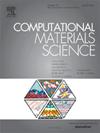Enhanced tunnel electroresistance in BAs/In2S3 ferroelectric tunnel junction through ferroelectric control of band alignments
IF 3.1
3区 材料科学
Q2 MATERIALS SCIENCE, MULTIDISCIPLINARY
引用次数: 0
Abstract
We have designed two-dimensional ferroelectric tunnel junctions (FTJs) utilizing BAs/InS van der Waals heterostructures and explored their transport characteristics. At low bias voltage, a pronounced difference in current magnitudes under different polarization states is observed, leading to a giant tunneling electroresistance (TER) ratio of . Analysis of the projected band structures reveals changes in band alignment from type-III to type-I under the ferroelectric polarization reversal. Further discussions indicate that polarization reversal can cause a variation in the total charge transfer, consequently altering the Fermi level’s position in the BAs and InS layers. This alteration results in a transition between metallic and semiconducting states, thus achieving a high TER ratio. These findings imply great potential of high-performance 2D FTJs, which may contribute to the development of non-volatile storage devices and ferroelectric field-effect transistors.

利用BAs/In2S3范德华异质结构设计了二维铁电隧道结(FTJs),并对其输运特性进行了研究。在低偏置电压下,不同极化状态下的电流大小存在显著差异,导致隧道电阻(TER)比高达108%。通过对投影带结构的分析,揭示了铁电极化反转作用下带向从iii型到i型的变化。进一步的讨论表明,极化反转可以引起总电荷转移的变化,从而改变费米能级在ba和In2S3层中的位置。这种改变导致金属态和半导体态之间的转变,从而实现高TER比。这些发现暗示了高性能二维ftj的巨大潜力,这可能有助于非易失性存储器件和铁电场效应晶体管的发展。
本文章由计算机程序翻译,如有差异,请以英文原文为准。
求助全文
约1分钟内获得全文
求助全文
来源期刊

Computational Materials Science
工程技术-材料科学:综合
CiteScore
6.50
自引率
6.10%
发文量
665
审稿时长
26 days
期刊介绍:
The goal of Computational Materials Science is to report on results that provide new or unique insights into, or significantly expand our understanding of, the properties of materials or phenomena associated with their design, synthesis, processing, characterization, and utilization. To be relevant to the journal, the results should be applied or applicable to specific material systems that are discussed within the submission.
 求助内容:
求助内容: 应助结果提醒方式:
应助结果提醒方式:


